Good morning Uwek. Thank you for this response. It is much appreciated. I wanted to build the HMS Enterprise 1:48 POF as my next model, however there is some legal challenges with this kit and not available. In the meantime I will read some so I start to understand these ships more. Cheers GrantMany Thanks to @pianoforte , @Steef66 , @Mirek , @KurtFink , @Ken , @Corsair and @GrantTyler for your kind words and comments and also for all the likes received - I like it very much to get comments and try to answer all the question, especially if I do know the answer - or to give my try to answer, also and maybe especially when there is some additional research necessary.
Dear Grant,
somehow, the use of wooden treenails, or bolts (circular or rectangle, in iron or copper) on my model(s) is off course somehow my personal taste, but also based on some knowledge from different publications. And this "knowledge" is grown over the years with the different models
My Granado model is following as much as possible the given informations by Peter Goodwin in his Anatomy of Ships series
Book review - Book Review: "The Bomb Vessel GRANADO (Anatomy of the Ship)" by Peter Goodwin
Book Review: The Bomb Vessel GRANADO (Anatomy of the Ship) by Peter Goodwin Hardcover: 128 pages Publisher: Conway Maritime Press; New edition edition (21 April 2005) Language: English Product Dimensions: 26 x 1.9 x 24.1 cm Synopsis: Built as a floating siege engine able to...shipsofscale.com
so let us take a first look here - in some sketches are some iron bolts shown (photos taken from my hard-disc of my PC - there are more in the book)
for the frames and the keelson
View attachment 449003
for the keel
View attachment 449004 View attachment 449005
also the mast foots
View attachment 449013 View attachment 449014
Bowsprit step
View attachment 449018 View attachment 449019
lodging and hanging knees + beam arms connections
View attachment 449016 View attachment 449017
I am pretty sure, that there is also something visible or written about using bolts for the wales and / or the inner thick stuff
But I think, that all structural elements with some specific thickness were connected with metal / iron bolts and not with wooden treenails - they can not be made so long
slightly contrary about the construction of frames (especially related to chock connections) is written in Laverys book - here he is writing "bolts and trennals"
View attachment 449020 View attachment 449021 View attachment 449022
View attachment 449023 View attachment 449024 View attachment 449025
View attachment 449026View attachment 449027
-

Win a Free Custom Engraved Brass Coin!!!
As a way to introduce our brass coins to the community, we will raffle off a free coin during the month of August. Follow link ABOVE for instructions for entering.
-

PRE-ORDER SHIPS IN SCALE TODAY!
The beloved Ships in Scale Magazine is back and charting a new course for 2026!
Discover new skills, new techniques, and new inspirations in every issue.
NOTE THAT OUR FIRST ISSUE WILL BE JAN/FEB 2026
You are using an out of date browser. It may not display this or other websites correctly.
You should upgrade or use an alternative browser.
You should upgrade or use an alternative browser.
HMS GRANADO - full hull - POF kit by CAF in 1:48 - by Uwe
It may be time to invest in buying some books...Yes - definitely helpful - often I mix them up
Book review - Book Review / Look Inside: "The Arming and Fitting of English Ships of War, 1600-1815" by Brian Lavery
Arming and Fitting of English Ships of War 1600-1815 by Brian Lavery Hardcover: 319 pages Publisher: Naval Inst Pr; 1st Edition edition (March 1, 1988) Language: English ISBN-10: 0870210092 ISBN-13: 978-0870210099 Product Dimensions: 10.2 x 1 x 12 inches Shipping Weight: 3.9 pounds...shipsofscale.com
and the third one very helpful is the Lees
Book review - The Masting and Rigging of English Ships of War, 1625-1860" by James Lees
An other cornerstone in each private library describing the mast, spars and the complex rigging work should be The Masting and Rigging of English Ships of War, 1625-1860 By James Lees Publisher: Naval Institute Press; 2nd Rev edition (October 1984) Pages: 212 ISBN-10: 0870219480...shipsofscale.com
Yes - these three books are helping a lot to understand the structure and the "working" of english shipsIt may be time to invest in buying some books...
-> very helpful (especially the Lavery and the Goodwin) when you start with POF models
for french ships I recommend the Volume 1 to 3 of Jean Boudriot series of the 74 gun ship - you can find book reviews also here in SOS
I totally agree with Adi, your build is fantastic Uwe and a feast for the eyes.I can only repeat it, simply a super model, beautifully executed.
that's the one I'm waiting for too, from Modelship Dockyard.Good morning Uwek. Thank you for this response. It is much appreciated. I wanted to build the HMS Enterprise 1:48 POF as my next model, however there is some legal challenges with this kit and not available. In the meantime I will read some so I start to understand these ships more. Cheers Grant
I should specify that it's the next one I'm looking to purchase. I'll probably build something else between now and building the Enterprise.
Jeff
That is a true story. I have the art of rigging which I used like 10% of when building my Victory, now it is time to understand the structure and how these ships are put together. Thanks again Uwek. Cheers GrantYes - these three books are helping a lot to understand the structure and the "working" of english ships
-> very helpful (especially the Lavery and the Goodwin) when you start with POF models
for french ships I recommend the Volume 1 to 3 of Jean Boudriot series of the 74 gun ship - you can find book reviews also here in SOS
Today I would like to give an overview of the lower hull segment - mor or less finished with all necessary interior features and elements - the next will be the treatment of the frames with CLOU
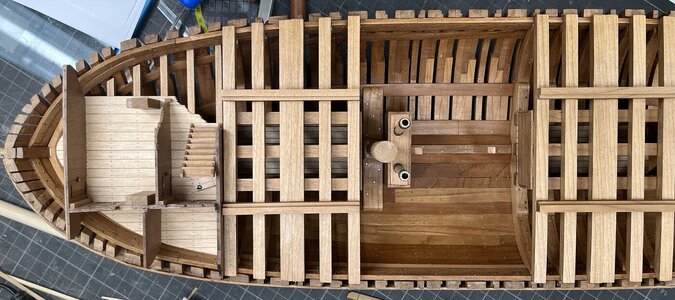
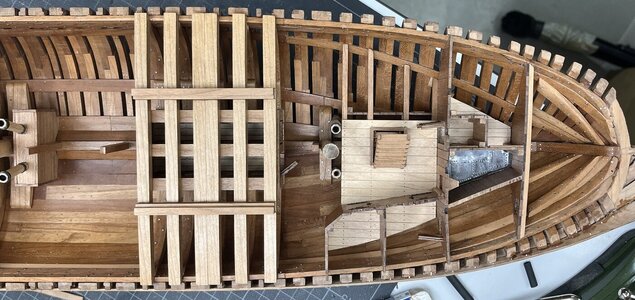
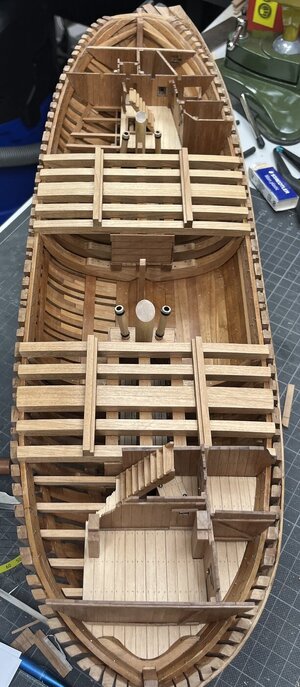
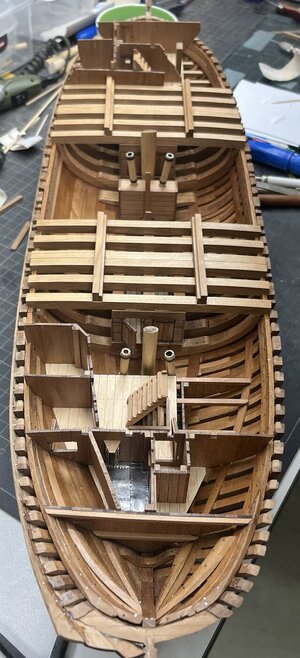

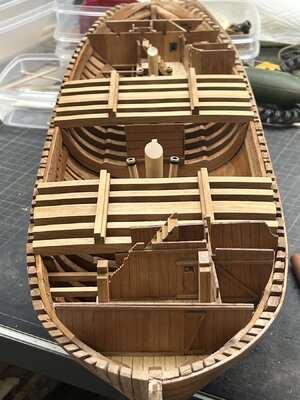
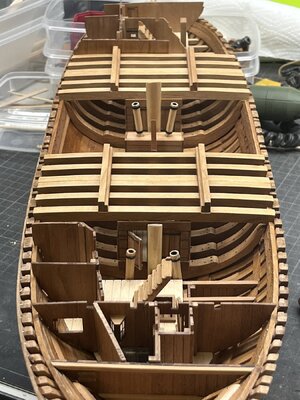
Tomorrow is a public holiday here in Austria so I hope be able to stay some hours in the workshop ......
Many Thanks for your interest .... to be continued







Tomorrow is a public holiday here in Austria so I hope be able to stay some hours in the workshop ......
Many Thanks for your interest .... to be continued
- Joined
- Oct 23, 2018
- Messages
- 871
- Points
- 403

Uwe,
before you start with Clou, you should remove the wooden "pins" on the bottom of the keel. These are only necessary to fix the keel in the jig.
before you start with Clou, you should remove the wooden "pins" on the bottom of the keel. These are only necessary to fix the keel in the jig.
I still keep them, because they are protecting the keel against some damages - the keel can be "Clou-ed" also laterUwe,
before you start with Clou, you should remove the wooden "pins" on the bottom of the keel. These are only necessary to fix the keel in the jig.
Beautiful work Uwe, so very impressive. Enjoy your workshop holiday tomorrow  .
.
Most impressed Uwe. Have a nice day off working on your ship.
Have a question what is CLOU?
CLOU
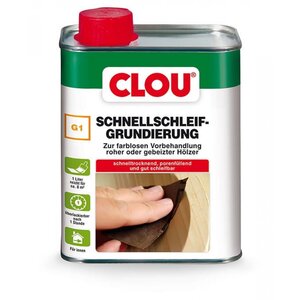
available in central Europe - it is wood sanding primer and here in our region often used instead of oil or other wood treatments

G1 Schnellschleif-Grundierung
Eigenschaften: Farblose Nitrocellulose-Kunstharz-Grundierung, sehr füllkräftig, schnell trocknend, für rohe oder gebeizte Hölzer.Verbrauch: 1 Liter reicht für ca. ...
 www.clou-shop.eu
www.clou-shop.eu
Ok yes, we have a similar product over here that I use for my carvings. that is called Feast Watson Sanding Sealer and is very good to use as it dries quickly and when you sand over with sandpaper it finishes well. Always have it on hand. Very similar to the Dope we used on model airplane wings in the day.CLOU
View attachment 450111
available in central Europe - it is wood sanding primer and here in our region often used instead of oil or other wood treatments

G1 Schnellschleif-Grundierung
Eigenschaften: Farblose Nitrocellulose-Kunstharz-Grundierung, sehr füllkräftig, schnell trocknend, für rohe oder gebeizte Hölzer.Verbrauch: 1 Liter reicht für ca. ...www.clou-shop.eu
For most of my models, I use French polish and then finish with wax. However, I have done carvings and models with French polish only. Now, I do use a brush and paint it on. This way I can get the finish I want. I will begin a prelude to my build of the Bounty showing some of the models I have made. I find French Polish is so much quicker to use as its drying times are fantastically quick.
Wow Uwe! I don't know what's been distracting me while you made all of this progress on your Granado! I think I am aboard now, though. This is magnificent work Uwe.
Absolutely love the way the cutaway allow us all to see so clearly, what is usually hidden deep below other decks! The work you are doing on the details gives us all new insights and views of critical structure and construction methods.
Thanks for sharing such wonderful pictures of this unique, educational and awesomely crafted masterpiece!
Thanks for sharing such wonderful pictures of this unique, educational and awesomely crafted masterpiece!
Wow Uwe, what an astonishing foto's you showed us.
- Joined
- Jun 17, 2021
- Messages
- 3,175
- Points
- 588

Truely wonderful, amazing and inspiring work!

Really fantastic work Uwe. You did a damn good job and it looks really cool when it's shown in the two halves on top of each other.
Hi Uwek,View attachment 446296
View attachment 446297
View attachment 446298
View attachment 446299
View attachment 446300
View attachment 446301
View attachment 446302
View attachment 446303
View attachment 446304
View attachment 446305
View attachment 446306
View attachment 446307
View attachment 446308
enough for now - many thanks for your interest - and hope to see some of you in Augsburg
Just a question about this magnificent model with all the nails used, were they brass or copper?
Also another question. each nail, a hole was drilled?
Gary




